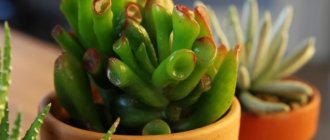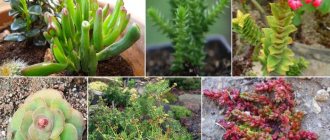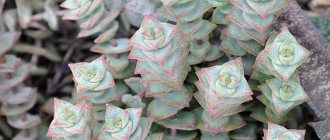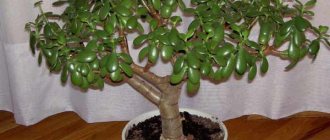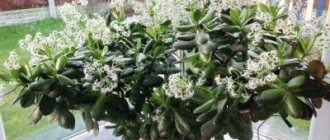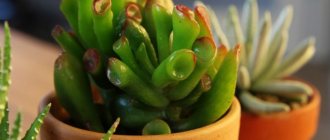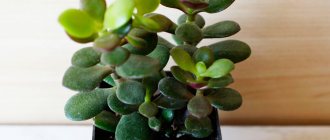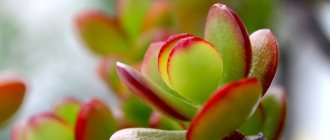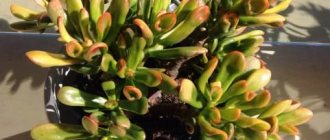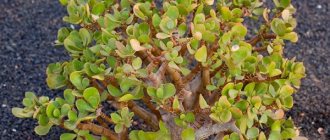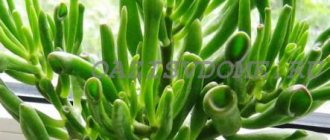Updated: May 23, 2022 / Crassula
Crassula got its Russian-language name for its dense succulent leaves. I like the tree-like types of Crassulas for their ease of formation and the possibility of obtaining an original man-made tree. These wonderful plants have a thick, woody trunk, the cuts of which quickly become overgrown. Crassulas are best formed by pruning and stretching.
Crassulas are very unpretentious in care. In winter, they require almost no attention - just keeping them cool (in my conditions, it’s a window sill, right next to the glass) and watering once a month, when the leaves become slightly lethargic. In summer, without shading, plants sunbathe on the loggia from the end of March to November, withstanding differences in night-day temperatures.
In hot summer weather, if the fat plant is placed on a sunny windowsill indoors, you need to water it carefully - in the evenings, almost every day. At temperatures of 30–40 °C, plants become stagnant and can easily rot after untimely heavy watering.
The following species of tree-like crassulas were in my collection.
Crassula ovata obliqua
Crassula ovata obliqua is distinguished by its characteristic pointed tip of the leaf. A striking representative of this variety of Crassula is the variegated Crassula ovata obliqua var. Tricolor with pure white chlorophyll-free stripes on the leaves:
Crassulla Tricolor
Crassula Tricolor grows slower than other species and branches reluctantly. In good light, the underside of the leaf takes on a rich crimson color.
2010, Petr Lapshin, When reprinting, please include a link
“Money tree” is a plant with a thick trunk and oval succulent leaves, belongs to the genus Crassula or Crassula. At home, these plants easily reach a height of half a meter, and in good conditions even a meter with a similar crown width. In botanical gardens, when planted in the ground, as well as in nature or in regions with a warm climate where there is no frost, they grow up to two meters and higher. “Money trees” grow as miniature trees with a thick trunk and usually have shiny green or bluish-silver leaves, often with red bottoms in the sun, succulent and dense, or soft and rather thin and even wavy. All varieties develop a powerful trunk, as thick as an arm at the base, from which numerous thick branches extend. As a result, the developed plant imitates a tree, although morphologically it is a herbaceous plant that does not form wood.
In total, you can count a little more than 10 varieties of “Money Trees”. All varieties of these plants come from two species: Crassula ovata - Oval Crassula (synonyms: C. portulacea - purslane, C. argentea - silver) and Crassula arborescens - Tree Crassula. The first type has bright green shiny leaves, the second has silver or blue-gray leaves. Depending on the variety, the leaves can be of different shapes and sizes.
| Oval Crassula (Crassula ovata). Plant in the collection (A.E. Migach, department of succulents “Kviti Ukrayiny”, Kyiv) | Flowers of Crassula oval (Nikitsky Botanical Garden, Yalta). | Crassula ovata, leaves close-up. |
Crassula is a large genus that includes a variety of herbaceous and bushy plants, about 150 species in total and about the same number of cultivated varieties of hybrid origin. The name of the genus Crassula, Crassula, comes from lat. crassus - thick. Crassulas are most widespread in Africa (mainly South and East), as well as Madagascar and Asia. Some species are widely cultivated and have even become naturalized on other continents. All Crassula leaves are opposite (they come off the stem in pairs), simple, entire, often fused at the base, usually quite succulent. The flowers are small, star-shaped, white, yellowish, red, pink-lilac. Some species bloom very profusely, forming rich inflorescences, behind which leaves are often not visible. The flowers of many species have a sharp, sugary odor and are pollinated by flies and other not very picky insects. Many Crassulas (including “money trees”) can bloom only when the days are short, that is, in winter. But in Russia, in our climate, the conditions for flowering in winter are very poor: it is constantly cloudy and dark. Therefore, due to insufficient lighting at home, many Crassulas and “money trees” usually do not bloom at all.
| Oval Crassula (Crassula ovata). In direct sun (without glass), the leaves may turn yellow-red. | Large old Crassula ovata plant in the ground, height approximately 1.5 meters (in the Fomin Botanical Garden, Kyiv) | Crassula ovata v mivor variety “Crosby's Compact” (photo by P.V. Lapshin) |
Oval Crassula - Crassula ovata
a natural species from South Africa (Transvaal, Cape Province) is the most common variety of “money trees” (synonym Crassula portulacea). This is a rather large plant for home succulents with a thick, erect trunk, a spreading crown, a large number of branches, densely strewn with dark green, oval, succulent leaves. Adult plants grow up to half a meter in height in 5-10 years, sometimes more. This Crassula is one of the most common indoor plants. Popular names: “money” or “coin” tree are given for the shape of the leaves: round and shiny.
Variety "Crosby's Compact"
This is a variety of Crassula oval with small, usually reddish leaves. The leaves are about 1.5 cm long, rarely larger, and about 1 cm wide. The plant growth rate is slower in direct proportion to the smaller leaf sizes. The variety is convenient to use for mini-gardens when large plant sizes are not needed.
Crassula oval shape appearance
(Crassula ovata var. obliqua). It is distinguished by a clearly visible, triangular, pointed tip of the leaf. The leaves are usually curved: sides down, tip up and oriented vertically relative to the stem, and not horizontally, like ordinary ovata. In addition, the leaves are somewhat larger. This variety is somewhat less common than the common Crassula ovata. The variety has two variegated forms with yellow stripes (cv. Solana) and white (cv. Tricolor).
| Crassula ovata var. obliqua | Crassula ovata var. obliqua | Two varieties: on the right C. ovata, on the left var. obliqua. |
Varieties 'Hobbit' and 'Gollum'
These two varieties of Crassula ovata with interesting tubular leaves are very original. These are two similar varieties: in 'Hobbit' most (but not all) of the leaves are turned outward and fused from the base to the middle, while in 'Gollum' they are already completely tubular with a funnel-shaped extension at the end. Presumably both varieties are hybrids of C. ovata with the participation of C. lactea (Crassula milk). These varieties began to spread from the USA in the 1970s from the Abbey Gardens Nursery owned by D. Black. Currently, of these two varieties, the variety 'Gollum' is widely distributed, but they are usually called simply 'Hobbit' for convenience. The growth pattern is exactly the same as Crassula ovata, it is a spreading “tree” with a thick trunk and even gnarlier branches. The trunk is strong, succulent, segmented (with traces at the places where leaves are attached), intensively branched, and can be valuable for creating very interesting forms using the bonsai technique. It grows somewhat more slowly, but not significantly. The height of a developed plant can be up to 50-80 cm and higher with a proportional crown width. Blooms in winter with pinkish-white star-shaped flowers.
| Crassula cv. 'Gollum' | Crassula cv. 'Gollum' | |
| Large plant Crassula cv. 'Gollum' | Crassula cv. 'Gollum' | Crassula lactea |
Crassula tree (C. arborescens)
A significantly more powerful and larger plant with much more massive and juicy, often not even oval, but rounded bluish leaves with a red bottom. Leaves are up to 5-7 cm long, 4-5 cm wide, broadly oval, often have small dark dots on the upper side of the leaf.
| Crassula tree (C. arborescens) | Crassula tree (C. arborescens) | Crassula tree (C. arborescens), Nikitsky Botanical Garden, Yalta |
Crassula tree, form of undulatifolia.
. The leaves are silvery-bluish, narrow and relatively not succulent, 5-7 cm long, 3 cm wide, the tip below is often red, the leaves are located vertically relative to the stem.
| Crassula tree (C. arborescens) | Left C. ovata right C. arborescens | Crassula arborescens ssp. undulatifolia (Botanical Garden named after N.N. Grishko, Kyiv) |
| Crassula arborescens subsp. undulatifolia cv. 'Blue Bird' (P. Lapshin) | Crassula arborescens ssp. undulatifolia (Nikitsky Botanical Garden, Yalta, Crimea) | Crassula Blue Bird |
Crassula tree, variety Blue Bird (Blue Bird)
. A variety with curly wavy leaves.
| Variegated forms |
There are 5 variegated varieties of money trees. Crassula has two ovates: “Hummel's Sunset” with clear yellow stripes and a smooth transition of color (usually losing color), two in its appearance form: “Solana” and “Tricolor” and one variety in Crassula arborescens ssp. undulatifolia f. variegata.
Crassula variety "Solana"
(Crassula ovata var. obliqua cv. Solana). The leaves bear asymmetrical bright yellow stripes, their number varies from shoot to shoot, and sometimes completely green branches appear, which it is advisable to remove, otherwise the variegated ones will be gradually crowded out as the bush grows. This varietal name is from the Main Botanical Garden. N.V. Tsitsin in Moscow.
| Crassula obliqua cv. Solana (A.E. Migach, department of succulents “Flowers of Ukraine”, Kyiv) | Crassula obliqua cv. Solana (Botanical Garden named after Fomin, Kyiv) | |
Crassula variety "Tricolor"
(Crassula ovata var. obliqua cv. Tricolor). The stripes are white against a background of clearly visible red edging.
| Crassula argentea f. variegata cv. Tricolor (P. Lapshin) | Crassula argentea f. variegata cv. Tricolor (P. Lapshin) | |
Crassula ovata variety “Hummel's Sunset”
There are two varieties distributed under this name. yellow and white, asymmetrical, longitudinal stripes on the leaves, mainly along the edges, and pink color, due to which the leaves turn bright yellow-red. The Dutch offer for sale an imitation of the Hummel's Sunset variety of unearthly beauty, also with a violation of chlorophyll synthesis, but which only appears in bright sun at high temperatures (in a greenhouse in summer). When sold, the leaf of this form is also red-yellow, but quickly loses its bright color at home and always remains that way.
| Crassula ovata "Hummel's Sunset" | Hummel's Sunset "disappearing" in the background |
Crassula tree, form undulatifolia f. variegata.
. The leaves are silvery-bluish, narrow and relatively not succulent, 5-7 cm long, 3 cm wide, the tip below is often red, the leaves are located vertically relative to the stem. A variety with yellow stripes on the leaves.
| 12. Crassula andulifolia f. variegata |
| Crassula arborescens subsp. andulifolia f. variegata (P. Lapshin) | Crassula arborescens subsp. andulifolia f. variegata (P. Lapshin) |
Such is the variety of “money trees” that currently exist in decorative floriculture. As for keeping these plants at home, in cultivation these plants are quite unpretentious, subject to the usual rules for keeping succulent plants: sunny location and moderate watering. Crassulas are succulent plants, that is, light-loving and drought-resistant. Their succulent leaves store moisture to survive dry periods. They are juicy not because they love water very much, but because they are ready to live without it for a long time on their reserves. Therefore, water in the summer - as the top layer of the substrate dries, and in the winter - 1-2 times a month when kept cool in close proximity to the glass. This watering regime is necessary because in winter there is not enough light in apartments for normal growth, even on window sills, so if you give enough water, these plants will stretch out and lose their decorative appearance. And if you water very rarely, they will not be able to grow and will not lose their attractive appearance. The first species (C. ovata) and all its varieties and varieties are very resistant to rotting, but the second species (C. arborescens) are very sensitive to rotting, especially in winter. If Crassula ovata can take root in water and live in a relative swamp and in low light, then Crassula arborescence arborescens is already a “decent” succulent and is not prone to compromises in care. Therefore, it is not very common, although it is very decorative.
List of varieties listed in this article:
- Crassula ovata - Crassula oval (synonyms: C. portulacea - purslane, C. argentea - silver) Crassula ovata Minor (Crosby's Compact) Hummel's Sunset Hummel's Sunset f. variegata Hobbit Gollum (Coral)
- Crassula ovata ssp. obliqua f. variegata Solana f. variegata Tricolor
- Crassula arborescens
- Crassula arborescens ssp. undulatifolia Blue Bird Crassula arborescens ssp. undulatifolia f. variegata
Author Peter Lapshin
, 2009, 2010. I do not mind copying this article, but if you reprint it, please let me know about it and post a link to my website www.lapshin.org/succulent Let's respect each other's efforts.
A similar review article about the same plants Easy Succulents- the Jade Plants
— Geoff Stein, Davesgarden.com
Crassula ovata cv. Hummel's Sunset
Crassula "Sunset" has a pronounced red edge along the yellow edge of the leaf:
Crassula ovata cv. Hummel's Sunset
The most amazing thing is that my specimen, purchased in a store, after a month on a sunny windowsill lost all this beauty and turned into an ordinary green-leaved Crassula ovata. But there is no doubt about the existence of this variety - there are photos of wonderful adult specimens on the Internet.
Reproduction
Sunset is most often propagated by leaves and cuttings (which can be obtained through planned pruning).
Cuttings are the easiest and most convenient way:
- Cut stems about ten centimeters long should be slightly dried in the shade, then rooted in a glass of water (adding charcoal).
- After the roots appear, plant them in a pot of the same size.
- Cover the crassula with a transparent plastic cup on top.
- We periodically water and ventilate the “greenhouse”.
- The cuttings have sent out shoots - remove the glass.
Another interesting method of propagation is shoots with aerial roots that appear on the woody stems of the Crassula. Such a shoot with fresh living roots can be broken off and immediately planted in the ground.
You should not replant Crassula Sunset too often . In the first years of its life, when it is actively developing, it can be moved once a year to a larger pot. Then - no more than once every three years. This is usually done in the spring, but it is not forbidden to replant in the fall.
Reproduction methods
There are several ways to propagate a money tree - from cuttings, leaves and seeds.
Cuttings
The cuttings are harvested in the spring. Take an adult and healthy plant, carefully separate the lateral shoots with several leaves from the stem. Place in a container with warm water.
To stimulate the rapid appearance of roots, you can add a little Epin or Kornevin.
Stems with roots are planted in a nutrient substrate.
Leaf
Roots may form on the leaves
Some leaves may produce thin roots. You can also get new plants from them. Carefully separate it from the stem along with the root, then plant it in a light and loose mixture of compost soil and sand (1:1). Moisten and cover with film.
Keep in greenhouse conditions until new leaves appear.
The seedlings are periodically moistened and ventilated. When they get stronger and grow 2-3 pairs of leaves, they are planted in clay pots.
Seeds
Seeds collected from an adult plant are sown in bowls or seedling boxes filled with a nutritious and light mixture of leaf soil and coarse sand (1: 0.5). Spray with warm water from a spray bottle, then cover with transparent film or glass.
To prevent the appearance of mold, seedlings are ventilated every day.
The glass is removed after about 2 weeks, when sprouts appear. As soon as they grow and get stronger, they are dumped into separate containers - you can use disposable small cups with holes in the bottom.
For picking, take a mixture of turf, leaf soil and sand. Grow at home in a warm and well-lit place.
As soon as one pair of leaves appears on the plants, they are planted in pots with a diameter of 5-7 cm. They are kept at a temperature of 16-17°C for 2-3 weeks, then transferred to a permanent habitat with other flowers.
Characteristics and description
Crassula ovalis is a shrub that has a branched stem, which as the plant matures turns into a trunk and becomes woody. That is why the fat plant will appeal to those who are interested in bonsai - growing indoor trees.
The plant has many leaves. They are round, meaty and juicy. The surface of the leaves is shiny, without plaque. They can be bright green or silvery grey. From the bright sun they sometimes acquire a red edging. White specks may also appear on the surface of the leaves.
Purchase and adaptation
The flower is replanted every three years
The purchased plant is quarantined for 20 days. During this time, you will be able to determine whether it has parasites or an infection.
It is replanted using the method of transferring an earthen clod. This procedure is mandatory, because Crassula will grow and develop poorly in purchased land.
Use a clay pot with drainage holes at the bottom.
The root system is superficial and branched, so the flowerpot should not be too deep, but wide. The diameter is 2-3 cm larger than the previous container.
- The bottom is sprinkled with expanded clay.
- Fill ½ of the volume with a nutrient composition of peat, turf, leaf soil, humus and sand, mixed in equal quantities.
- Turn over the root ball, add soil to the top, and water it.
- For quick adaptation, stable heat within 20-23° and good lighting without direct sunlight are required.
Diseases and pests
In advanced cases, it is recommended to treat the entire plant with insect repellent.
Dropping of leaves can also be considered a disease. This indicates either excessive watering or a draft. Move the tree to another location and remember to make sure the soil is dry before watering.
Crassula is a great option for beginning florists. It is very unpretentious, but at the same time very impressive and can decorate any collection of plants. And the magical properties of attracting financial well-being for some owners can be an additional plus in favor of the “money tree”.
Next you can see the photo of Crassula Ovata:

